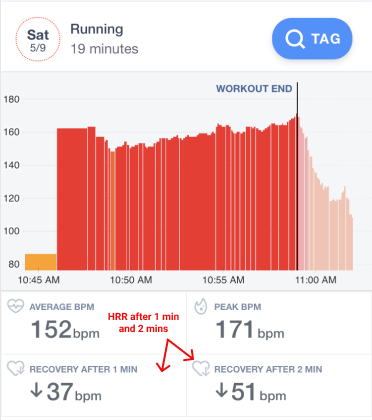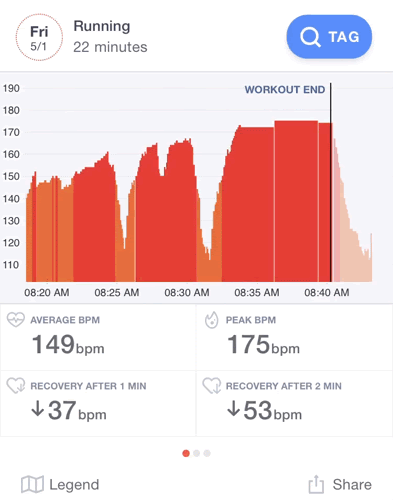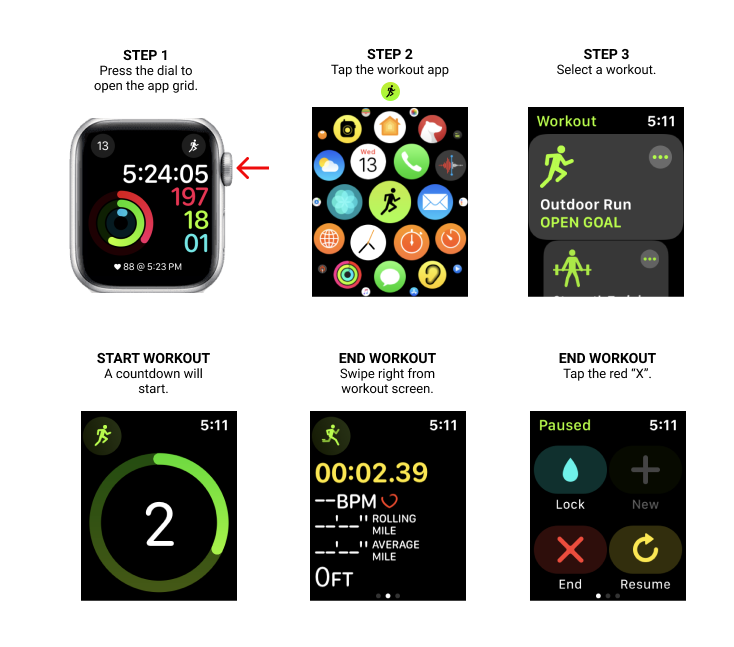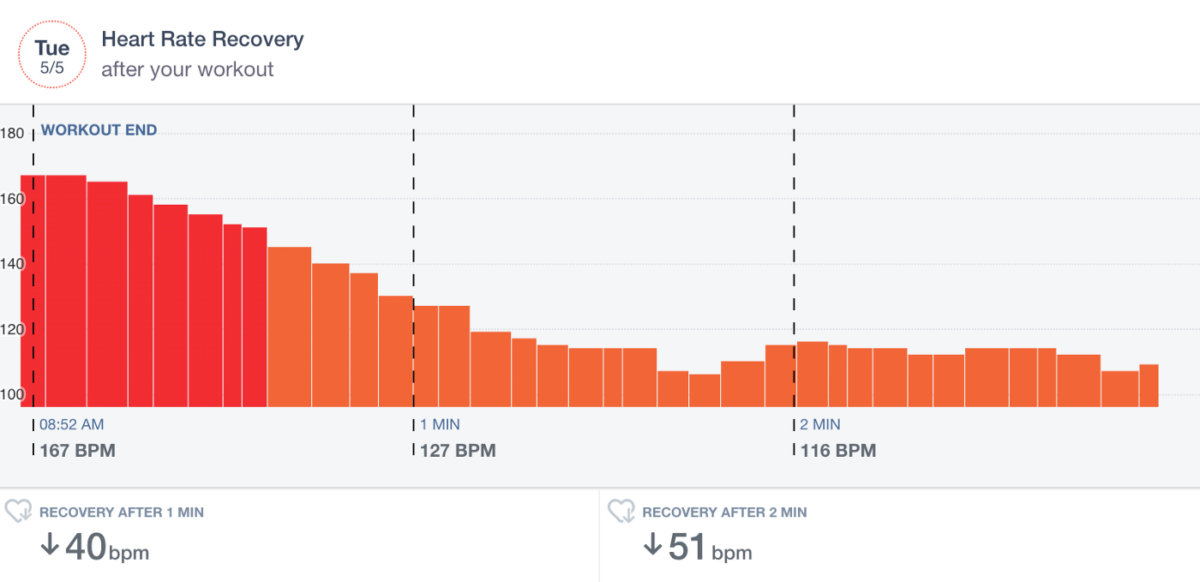What is HRR?
Heart rate recovery is how much your heart rate drops after you stop exercising. The most commonly measured timeframes are 1 minute after peak exercise (HRR-1) and 2 minutes after peak exercise (HRR-2).
For example, an HRR-1 of ↓26bpm means that your heart rate decreased by 26bpm in the one minute after you stopped exercising.
In general, a larger drop in BPM after exercise indicates improvements in cardiovascular fitness.
Why is HRR important?
Your heart rate is regulated by your autonomic nervous system, which is broken up into sympathetic activity (“fight or flight”) and parasympathetic (“rest and digest”) activity. Your heart rate changes based on whether sympathetic or parasympathetic activity is more dominant at the time.
If your heart rate doesn’t appropriately drop after you stop exercising, it can indicate poor cardiovascular fitness or, in extreme cases, even a medical condition that is affecting your autonomic nervous system. The connection between HRR and your overall health has been shown in multiple studies:
HRR can predict overall health risk and mortality: a 6-year study found that patients with a heart rate drop less than 12 bpm one minute after peak exercise were at increased health risk than those with a “normal” HRR (>12 bpm drop)1.
Improving HRR via exercise significantly reduces mortality: the Cleveland Clinic studied a group of patients who started cardiac rehab after a heart procedure. They found that patients who improved their HRR to normal levels through exercise had significantly lower mortality than patients who did not2.
HRR as a predictor of atrial fibrillation: a 3-year study found that patients with low HRR (<12bpm) were more likely to develop atrial fibrillation3.
Independent connection between diabetes and HRR: Elevated fasting glucose levels (primary method of diagnosing diabetes) were shown to be connected with abnormal HRR, even after adjusting for age, sex, BMI, and more4.
Where to find HRR in Cardiogram
You’ll find one-minute and two-minute HRR as stats below any workout. You’ll also see a faded section for the three minutes after your workout.

If you swipe left twice on your workout, you’ll see the zoomed-in look at HRR-1 and HRR-2.

How to measure HRR
- When you exercise, make sure to turn on workout mode (see Device support and setup below). This increases the frequency of your heart rate sensor so you’ll get an accurate HRR reading.
- Towards the end of your workout, get your heart rate to at least 70% of your max heart rate. Assuming you don’t have any cardiovascular conditions and are not taking medications that affect your heart rate, your max heart rate can be estimated by subtracting your age from 220. E.g. if you’re 55 years old, your estimated max heart rate is 220–55 = 165bpm. So if you want accurate HRR readings, you should get your heart rate up to 165*0.7 = 116bpm.
- End your workout on your watch immediately after you stop exercising and your heart rate is at least 70% of your max heart rate.
- Rest for at least 2 minutes after you stop your workout. It’s okay to do a slow walking or stretching cool down, but try to avoid activities that could cause your heart rate to significantly increase, like jogging, lifting things, eating, drinking, etc.
- 2 minutes after you finish your workout, open the Cardiogram app to see your recovery after 1 and 2 minutes.
Add tags to track improvements in HRR
Whenever you exercise, turn on workout mode and select the correct type of workout so you can understand if your HRR differs based on the type of workout.
To get a full picture, contextualize your HRR with tags. Add tags for things that could affect your workout performance. For example, add a tag when you take your medications (e.g. beta-blocker), when you feel uncomfortable symptoms (e.g. headache, dehydrated), or meals you’ve eaten (e.g. heavy dinner).
Over time, you can use Cardiogram to track how your HRR improves and what factors affect it.
What factors are known to affect HRR?
Cardiovascular fitness: as you feel yourself becoming more fit, you should notice your heart rate dropping faster after exercise.
Medical conditions: particularly conditions that affect your cardiovascular or nervous systems like diabetes, SVT, POTS, or hypothyroidism.
Medications: like beta-blockers or calcium-channel blockers inhibit sympathetic activity. This affects how quickly your heart rate increases during exercise and how quickly it decreases after exercise.
Caffeine and alcohol: both have been shown to affect your heart rate via changes in sympathetic and parasympathetic activity 5 6.
What’s a “normal” HRR?
A “normal” HRR is defined differently depending on the study. Some studies say a normal HRR after one minute is a drop of more than 12bpm, others say it’s more than 18bpm7.
Rather than classifying your HRR as “normal” or “abnormal”, aim to improve your HRR over time.
Device support and setup
Right now, HRR on Cardiogram will work reliably with Apple Watch or Fitbit. We’re working on adding wearOS and Garmin support soon. To see the stat on your workouts, you’ll need to switch your wearable into workout mode when you’re exercising and turn off workout mode right at the end of your workout. Here’s how:
Apple Watch

Fitbit
Conclusion
Similar to resting heart rate and sleep BPM, heart rate recovery is another tool you can use to better understand your cardiovascular health.
We hope this new feature helps you understand your own wearable data, and empowers you to have more informed conversations with your doctor.
Cardiogram is compatible with Apple Watch, Fitbit, wearOS by Google, and Garmin wearables.
Questions?
If you have any trouble using heart rate recovery, check out this FAQ or email us at [email protected].
References
1Heart-Rate Recovery Immediately after Exercise as a Predictor of Mortality: https://www.nejm.org/doi/full/10.1056/NEJM199910283411804
2Impaired heart rate recovery is associated with new-onset atrial fibrillation: a prospective cohort study: https://www.ncbi.nlm.nih.gov/pmc/articles/PMC2660286/
3Association of fasting plasma glucose with heart rate recovery in healthy adults: a population-based study: https://diabetes.diabetesjournals.org/content/51/3/803.long
4Impact of Exercise on Heart Rate Recovery: https://www.ahajournals.org/doi/full/10.1161/circulationaha.110.005009
5Caffeine affects autonomic control of heart rate and blood pressure recovery after aerobic exercise in young adults: https://www.nature.com/articles/s41598-017-14540-4
6Moderate alcohol consumption, autonomic nervous system and mood: https://www.sciencedirect.com/science/article/abs/pii/S0195666313002870
7Stress testing to determine prognosis of coronary heart disease: https://www.uptodate.com/contents/stress-testing-to-determine-prognosis-of-coronary-heart-disease


